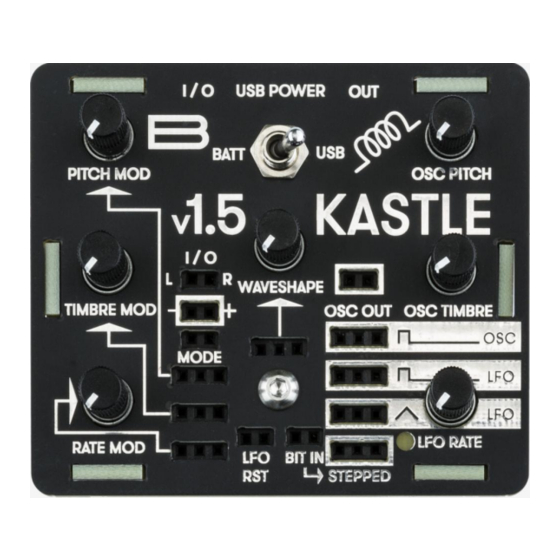
Advertisement
Quick Links
Advertisement

Subscribe to Our Youtube Channel
Summary of Contents for Bastl Instruments KASTLE v1.5
- Page 1 KASTLE BASTL INSTRUMENTS...
-
Page 2: What's In The Box
KASTLE v1.5 Features ● complex oscillator ● 3 synthesis modes on the main output: phase modulation, noise mode, track & hold modulation ● 3 more modes on the secondary OSC output: phase distortion, tonal noise mode, formant synthesis ● PITCH control with o set and CV input with attenuator ●... - Page 3 INTRODUCTION Kastle v1.5 is a mini modular synthesizer with a headphone output, 2 in/out ports for interfacing other gear and it runs on just 3 AA batteries or USB power. It is DIY friendly and ideal for beginners in modular synthesis, but it will add some quite unique functionality to any modular synthesizer system.
- Page 4 There are 3 more modes on the secondary OSC output: phase distortion, tonal noise mode and formant synthesis. Each mode utilizes one or two oscillators. The PITCH parameter controls the main oscillator, the TIMBRE sets the PITCH of the modulating oscillator and the WAVESHAPE depends on the synthesis mode.
- Page 5 INSTRUCTIONS Kastle is a mini modular synth and as in every modular synth the sounds are programmed by connecting outputs to inputs. Outputs are labeled by a silver outline around the patch points. Inputs don‘t have the silver outline. Feel free to also connect inputs with inputs and outputs with outputs.
- Page 6 2 PITCH Turn the OSC PITCH knob to adjust the PITCH of the main oscillator. A modulation signal can be connected to the PITCH MOD socket and the PITCH MOD knob controls the amount of the modulation. 3 MODULATION Turn the OSC TIMBRE knob to adjust the PITCH of the modulating oscillator.
- Page 7 to mix with the main waveform or it can be output separately via the I/O jack. 7 MODE The MODE socket lets you select the synthesis mode. The synthesis mode a ects both the OSC OUT and the SECONDARY OSC OUT. When nothing is connected the synthesis mode at OSC OUT is phase modulation and at SECONDARY OSC OUT is phase distortion.
- Page 8 more complex modulation curves. See Tips & Tricks section for more info. 10 LFO TRIANGLE The LFO TRIANGLE socket outputs a simple triangle waveform, but it can be altered by modulating the LFO RATE or triggering the LFO RST to get some complex modulation shapes.
-
Page 9: Tips And Tricks
When it is low it generates an 8 step pattern. When it is high it keeps generating a random pattern and when it is altering it generates a semi-random pattern. The STEPPED output is very useful for modulating every parameter in the Kastle synth or any external device with the I/O port. - Page 10 Di erent rise and fall times Connect the LFO PULSE to the RATE MOD socket. Now the RATE MOD and LFO RATE knobs set di erent proportions between the rise and fall time of the triangle. This will also create a swing e ect on the STEPPED waveform.
-
Page 11: Phase Modulation
● Connect SECONDARY OSC OUT to the LFO RST pin to create chaotic modulation waveforms. Kastle takes some common synthesis methods and implements them with a very lo-fi twist which gives it a very distinct character full of aliasing artifacts. SYNTHESIS TYPES Phase modulation (OSC OUT, MODE disconnected) - Page 12 sine wave thru soft synced sinewave all the way to the phase distortion. Track & Hold Modulation (OSC OUT, MODE connected to “+”) This is a not so common synthesis method. The main sine wave oscillator is going thru a comparator which turns it into a variable pulse width waveform which is gating a track &...
-
Page 13: Noise Mode
Because the combinations of formants are stepped, modulating the WAVESHAPE results in musical arpeggios. Noise Mode (OSC OUT, MODE connected to “-”) The Noise mode on Kastle is implemented by a granular playback of the flash memory (where the program is stored) of the sound processing chip. - Page 14 BASTL more info and video tutorials www.bastl-instruments.com...






Need help?
Do you have a question about the KASTLE v1.5 and is the answer not in the manual?
Questions and answers